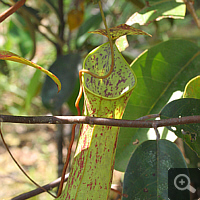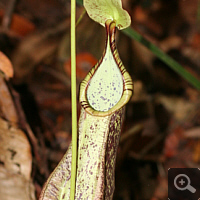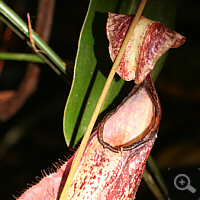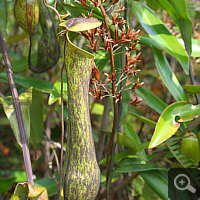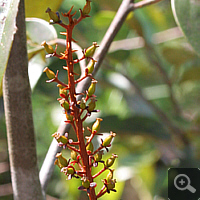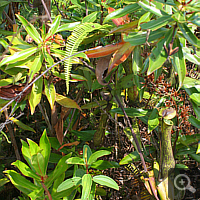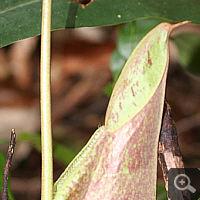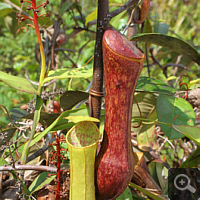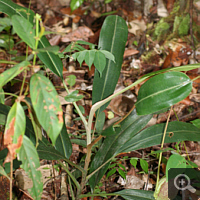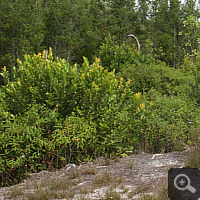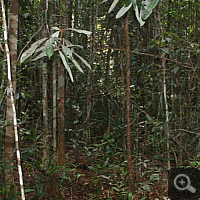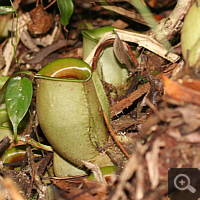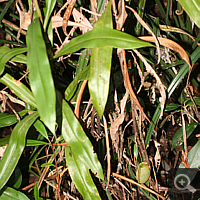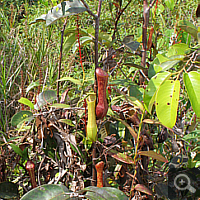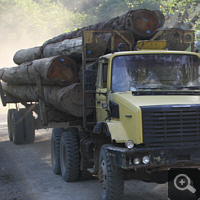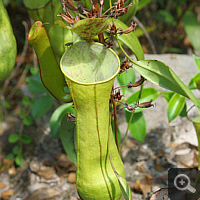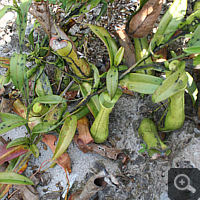Pitcher Plants (Nepenthes) in their natural habitat in Borneo 2011

Introduction
The genus of Pitcher Plants (Nepenthes) consists of circa 100 species and is only to be found in the tropical rainforests of Asia, Madagascar and Australia. The main distribution area is Indonesia.
The perennial Pitcher Plants with a subshrub- or liana-like growth belong to the carnivorous plants. The leaves are transformed to liquid-filled pitchers, with which the plants catch insects. These are digested with the help of enzymes.
Because of rainforest logging, swamp drainage and illegal withdrawal from nature by plant dealers the whole genus is threatened with extinction and is in the meantime protected by the Convention on International Trade in Endangered Species of Wild Fauna and Flora (CITES).
Historical information
First mention of this plant genus took place by the French governor of Madagascar, Étienne de Flacourt, in 1658. He called Nepenthes madagascariensis, which he found in those days, Amramitico, but he misconstructed the pitchers as flowers. A few years later, in 1680, the German researcher Jacob Breyne discovered Nepenthes mirabilis, which he called Bandura cingalensis. Just as Flacourt also Breyne didn’t realize the carnivory of the plant. First W.J. Hooker discovered in 1858 the insect catch of Pitcher Plants, a little more than hundred years after Carl von Linné, in 1753, gave the genus in his great work Species Plantarum the even today valid name Nepenthes.
In the meantime several fossils were found. The age statements differ, depending on the source, between 20 and 40 millions years. Evolutionary, Pitcher Plants are a relative old plant genus.
Plant description
Nepenthes are perennial plants. Most species grow terrestical, less species show an epiphytic growth. Some species produce rather indigenous rosettes, however is more often a subshrub- or liana-like growth with a length of up to 10 m to be found.
Single standing leaves arise from the main sprout, according to increasing growth height internodes are mostly extended. The leaves are complicated reformed. What looks like the basic leaf for the botanical layman, is in fact a broadened leaf node.
The basic leaf is converted to a sophisticated pitfall trap and serves insect capture. The leaf forms a hollow vessel, mostly of the kind of a tube or a cup, which is filled with an acidic liquid (pH-value partly < 3). Between species the volumes differ considerably, the greatest species reach values of 4 l.
With the aid of nectar secretions in the region of the ribbed and smooth trap margin ( peristome) insects are attracted, which in the end can slip of from the smooth margin and fall inward the trap, where they drown. Decomposition of the insects takes place by enzymes, which are produced by the plants themself. The traps are passive, the roofing cap is immobile and serves ultimately as a protection from dilution of the pitcher content by rainfalls.
Many species produce two kind of pitchers: ground pitchers and hanging pitchers. This phenomena is to understand as an adaption to crawling and flying insects.
Pitcher Plants are diocious.
Distribution
The main distribution area of Pitcher Plants is Indonesia. There are they mainly to be found in Borneo (34 species) and Sumatra (29 species). Outside of Southeast Asia becomes a disjunct distribution appearant. Relative isolated locations are to be found westward to Madagascar (2 species), northward to India (1 species) and southward to Australia (2 species).
All species are inhabitants of tropical rainforests, in which they grow mainly terrestical as subshrubs or liana-like, only a few species are epiphytes.
The biotopes partly differ significant concerning their climatic conditions, so that the genus is divided into lowland species and highland species.
Lowland species grow terrestical in humid, all-day warm rainforests below an altitude of 1000 m above sea level. These are mostly swamp rainforests. However, more than the half of all species inhabit highland rainforest above an altitude of 1000 m above sea level, in which is a considerable night-time temperature reduction. Above of 2000 m above sea level temperatures can fall just above freezing point.
Distribution in Borneo
You can find every third Pitcher Plant species in Borneo. Escpecially in Central and North Borneo are numerous extreme endangered highland species like Nepenthes rajah to be found in mountain rainforests.
The lowland species are mainly to be found in South Borneo. Unfortunately these swamp rainforests have escpecially suffered massive under destruction of the last years and decades and are often only fragmentary preserved. Over 70% of the rainforests of South Borneo were destroyed in not even half a century.
Primary for primates search we visited during our Borneo journey the swamp rainforest in the region of Tuanan.
Already along the road sides we found several species in bushes, which were there standing on almost pure sandy soil in full sun. The pitcher coloration was excellent. Either the very dry location during dry season, nor the full sun location caused any visible damages to the plants.
We found also in the swamp rainforest different Pitcher Plant species. Dominant species was here Nepenthes ampullaria, the second most common Nepenthes rafflesiana.
The swamp rainforest showed during our visit in the dry season an only slightly moist ground.
According to local people the location should be flooded partly 30 centimetres during rainy season. Also in dry season is humidity within the forest almost 100%, the temperatures were in the afternoon still almost 30°C. Light regime on the forest floor is very poor, there was only a sparse undergrowth by a very dense canopy of the forest.
Endangerment
More than half of all species are endangered and are threatened with extinction! By the IUCN are over 50 species classified in its Red List as critically endangered, endangered or vulnerable.
Accordingly the whole genus is protected by the Convention on International Trade in Endangered Species of Wild Fauna and Flora. Nepenthes rajah and Nepenthes khasiana are listed in Appendix I and are on the brink of extinction, the remaining species are listed in Appendix II.
Pitcher Plants are endangered by three factors. The main problem is the destruction of the natural habitats. On the one hand this is done by logging of tropical rainforests, on the other hand by drainage of marshy biotopes.
Especially in South Borneo drainage und logging reached dramatical proportions. Still in the sixties of the last century Borneo was almost complete covered by rainforest. In the meantime swamp rainforests are rare in Borneo, not even 30% of the initial stocks are preserved at the moment. Where not long ago species-rich, unique biotopes were to be found, the area is now exploited as agricultural land. Mono cultures: rice, pineapple, coconut or oil palms.
Not least are plant enthusiasts responsible for the extinction. Mainly in the past many plants were collected from nature, to finally die in the culture of hobby botanists. This problem is not as important as in the early days, but still persists. Also today some offered plants are not breedings, but from illegal wild collections.

